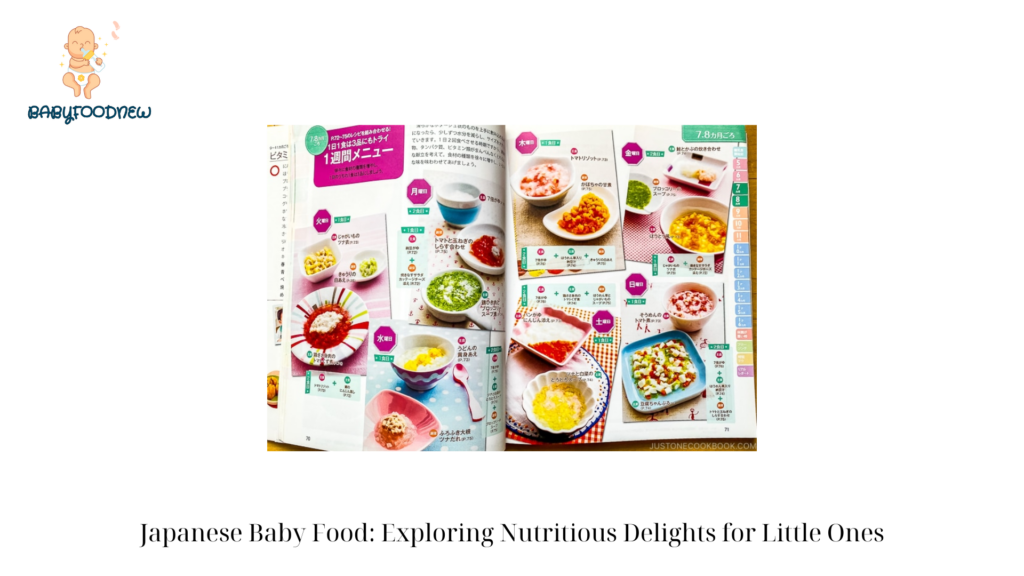Table of Contents
ToggleWord and Character Counter Tool
Type or paste your text below:
Total words: 0
Total characters: 0
When it comes to introducing solid foods to your baby, exploring different cultural cuisines can be an exciting and enriching experience. Japanese cuisine, known for its emphasis on fresh ingredients and balanced flavors, offers a wide array of nutritious options for your little one. In this article, Babyfoodnew will delve into the world of Japanese baby food, exploring its benefits, popular choices, and providing practical tips for incorporating these delightful dishes into your baby’s diet.
Japanese Baby Food: Exploring Nutritious Delights for Little Ones

The Benefits of Japanese Baby Food
Japanese cuisine is revered worldwide for its health benefits and focus on wholesome ingredients. By introducing Japanese baby food to your little one, you can provide them with a range of nutrients necessary for their growth and development. Japanese dishes often incorporate a variety of vegetables, seafood, and lean proteins, ensuring a well-rounded and balanced diet for your baby. Additionally, Japanese baby food tends to be low in salt and sugar, making it a healthy choice for little taste buds.
Popular Japanese Baby Food Choices
- Miso Soup: Miso soup is a staple in Japanese cuisine and can be a nutritious option for your baby. Made from fermented soybeans, miso is rich in probiotics, which promote a healthy gut. Start by diluting a small amount of mild miso paste in warm water and gradually increase the concentration as your baby grows accustomed to the taste.
- Rice Porridge (Okayu): Rice porridge, also known as okayu, is a comforting and easily digestible dish for babies. It is made by cooking rice with a higher water-to-rice ratio to achieve a soft, creamy texture. Okayu can be served plain or mixed with finely grated vegetables or cooked fish for added flavor and nutrition.
- Tofu: Tofu, made from soybeans, is a versatile ingredient in Japanese cuisine. It is a great source of plant-based protein and can be mashed or pureed to a suitable consistency for your baby. You can incorporate tofu into various dishes, such as tofu scramble or tofu and vegetable puree.
- Steamed Vegetables: Japanese cuisine places a strong emphasis on fresh and seasonal vegetables. Steaming vegetables, such as carrots, broccoli, and sweet potatoes, helps retain their nutrients while creating a soft texture for your baby to enjoy. Cut the vegetables into small, bite-sized pieces and steam until tender.
- Fish: Fish is a prominent component of the Japanese diet and can provide essential omega-3 fatty acids for your baby’s brain development. Opt for mild and low-mercury options such as salmon or cod. Steam or poach the fish until it flakes easily, then remove any bones and mash it into a suitable consistency.
Incorporating Japanese Baby Food into Your Baby’s Diet

Japanese baby food to your little one can be an exciting journey filled with flavors, textures, and nourishment. The emphasis on fresh ingredients, balanced meals, and gentle cooking techniques makes Japanese cuisine a healthy choice for babies. From miso soup to steamed vegetables and tofu, the options are diverse and provide a rich culinary experience for your little one. Remember to consult with your pediatrician, embrace gradual introduction, and enjoy the process of exploring the nutritious delights of Japanese baby food.
- Start Slowly: As with any new food, introduce Japanese baby food gradually. Begin with small portions and observe your baby’s reaction. Look for any signs of allergies or digestive issues. It’s best to consult with your pediatrician before introducing new foods, especially if there is a family history of allergies.
- Homemade vs. Store-Bought: While there are commercially available Japanese baby food options, making your own allows you to have complete control over the ingredients and preparation methods. Homemade baby food ensures freshness and allows for customization based on your baby’s preferences and dietary needs.
- Adapt to Texture and Consistency: Adjust the texture and consistency of Japanese baby food according to your baby’s stage of development. Start with smooth purees and gradually introduce more textured dishes as your baby progresses. Remember to mash or blend the food to a suitable consistency to prevent choking hazards.
- Flavor Exploration: Japanese cuisine offers a plethora of flavors for your baby to explore. Introduce different herbs and spices, such as ginger or mild curry powder, to enhance the taste of the dishes. However, be mindful of potential allergic reactions and introduce new flavors one at a time.
- Food Safety and Hygiene: When preparing Japanese baby food, ensure that all utensils, cutting boards, and cooking surfaces are clean and sanitized. Use fresh ingredients and store any leftovers properly in the refrigerator. Follow safe food handling practices to protect your baby from foodborne illnesses.

Conclusion
Introducing Japanese baby food to your little one can be an exciting journey filled with flavors, textures, and nourishment. The emphasis on fresh ingredients, balanced meals, and gentle cooking techniques makes Japanese cuisine a healthy choice for babies. From miso soup to steamed vegetables and tofu, the options are diverse and provide a rich culinary experience for your little one. Remember to consult with your pediatrician, embrace gradual introduction, and enjoy the process of exploring the nutritious delights of Japanese baby food.
Related Posts:
- Baby Nutrition After 1 Year: Essential Guidelines…
- Best Foods for Teething Babies: Soothing and…
- Top 10 Best High Fiber Foods for Babies 6 Months
- When Do Babies Stop Throwing Food: Understanding the…
- Can Dogs Eat Baby Food? Exploring the Safety and Benefits
- Introducing Papaya Baby Food: A Nutritious Choice…


